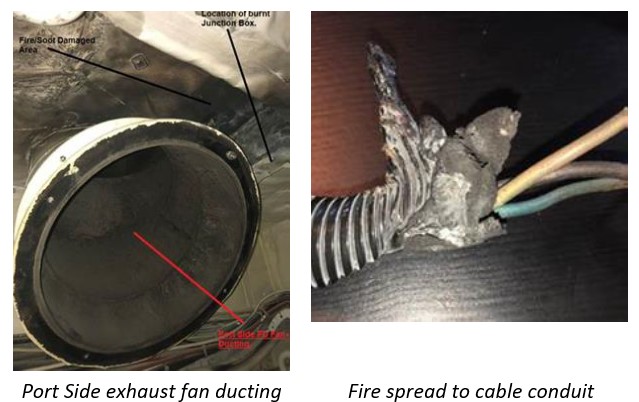Two incidents with electrical installations with potential for a fire
A member reported two incidents involving failure of electrical equipment, leading to, or potentially leading to, fire hazards.
Incident 1: Earth fault and potential fire hazard
What happened?
Whilst fault-finding an earth fault on the 240v mains system on a vessel, the engineers came across a pair of mains sockets installed above the galley fridge / freezer space. This space was not ventilated. These mains sockets were discovered to be heavily soiled by the fat residue that had drifted into this space from cooking in the galley.

What were the causes?
The fat residue was the immediate cause of the earth fault. This was clearly a potential fire hazard caused by the fat dripping down into the mains sockets. Causal factors identified were:
- Design flaws in the fitting of mains sockets in such a location;
- Ineffective extraction of fat fumes from the galley;
- Failure to clean the area around the mains sockets;
- Unclear / Inadequate instructions for galley maintenance.
Actions taken? Lessons learned?
- The entire area was cleaned comprehensively once the sockets were isolated and locked/tagged out;
- The sockets were inspected and replaced if necessary, and testing conducted;
- Checks to be made of difficult to access areas, high up areas and such in galleys to ensure nothing similar could occur elsewhere.
Members may wish to refer to
- Galley electric shock – uncontrolled portable electrical equipment
- Near miss: burnt out electrical socket
- Near miss: potential fire – overheating of oil in deep frying pan
Incident 2: Minor Electrical Fire in the Engine Room
A fire alarm was activated from within the machinery space, and on investigation, a minor fire was noted on the deckhead at the port side exhaust fan junction box. Given the limited size of the fire, it was tackled with a dry chemical powder extinguisher.

What were the causes?
Heating was caused by a breakdown in continuity in a terminal block inside a plastic junction box mounted on the machinery space deck head. The cable possibly suffered breakdown at the termination, or the connection in the terminal block joining the supply to the consumer had weakened, leading to reduced continuity (increased resistance) and consequent heating of the wires.
Actions
- Check physical and electrical condition of connections for high load or continuously running equipment;
- All terminations to be checked as a matter of routine during forth planned maintenance.
Members may wish to refer to
- Fire in engine space on crew transfer vessel (CTV)
- Fire in wheelhouse on offshore renewables crew transfer vessel
- Near-miss: burnt out electrical socket
For more information, please contact @imca-int.com.
Safety Event
Published: 26 November 2020
Download: IMCA SF 32/20
IMCA Safety Flashes
Submit a Report
IMCA Safety Flashes summarise key safety matters and incidents, allowing lessons to be more easily learnt for the benefit of all. The effectiveness of the IMCA Safety Flash system depends on Members sharing information and so avoiding repeat incidents. Please consider adding [email protected] to your internal distribution list for safety alerts or manually submitting information on incidents you consider may be relevant. All information is anonymised or sanitised, as appropriate.
IMCA’s store terms and conditions (https://www.imca-int.com/legal-notices/terms/) apply to all downloads from IMCA’s website, including this document.
IMCA makes every effort to ensure the accuracy and reliability of the data contained in the documents it publishes, but IMCA shall not be liable for any guidance and/or recommendation and/or statement herein contained. The information contained in this document does not fulfil or replace any individual’s or Member's legal, regulatory or other duties or obligations in respect of their operations. Individuals and Members remain solely responsible for the safe, lawful and proper conduct of their operations.
